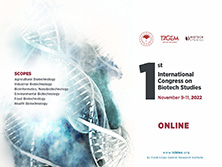Biotech Studies
2016, Vol 25, Num, 1 (Pages: 117-122)
Evaluation in terms of Resistance to Sunny Pest damage of Bread Wheat Genotypes with Different Phenological Characters
2 Namık Kemal Üniversitesi, Tekirdağ Ziraat Fakültesi, Tarla Bitkileri Bölümü, Tekirdağ DOI : 10.21566/tarbitderg.280298 - The research was conducted with 23 different varieties in field condition and closed area in 2010 and 2011. 23 different varieties of bread wheat were grown in open fields and closed areas in Tekirdağ Faculty of Agriculture testing regions. In the bread wheat, nifm number, sunn pest damage ratio, black point, protein ratio, moisture ratio, sedimentation rate, gluten rate and index and particle productivity features were analyzed. With the samples grown outdoors, the highest parasitism rate of sunn pest was in Tekirdağ sample with 3.08 % and followed by Alka, Renan, Sadova, Geya 1 and Krasnodarskaya-99 samples. The lowest parasitism rate was obtained from Enola and Dropia with 1.60%; Krasunia odes`ka with 1.63%. In bread wheat samples grown in closed areas, the parasitism of sunn pest rate increased considerably and measured between 4.93-12.75%. According to the average of two seasons, the highest parasitism rate was obtained respectively from Geya 1, Tekirdağ, Renan and Sadova samples. The lowest parasitism rates was obtained from Gelibolu, Kate A-1, Krasunia odes`ka and Dropia samples. When the quality features were analysed, gluten, gluten index, Zeleny sedimentation and retarted sedimentation values reduced substantially in comparison with values obtained outdoors. Retarted sedimentation values in all samples were at a quite low level that making the crop useless. Keywords : Sunn pest, quality, sunn pest rate, sedimentation, gluten
















